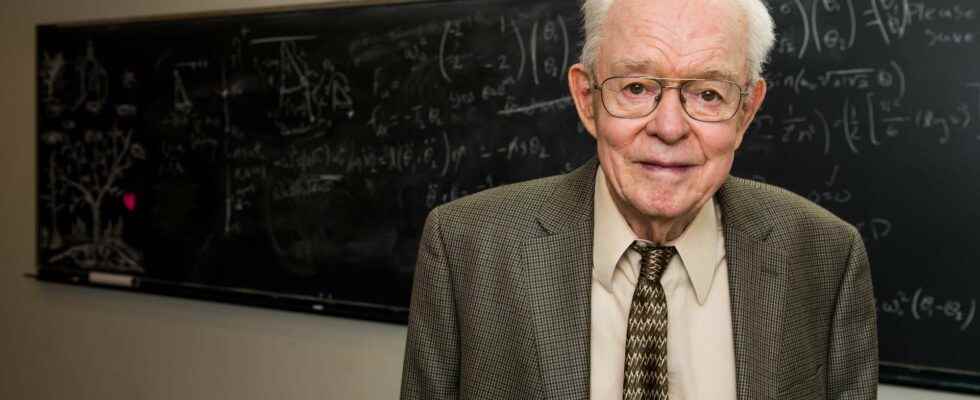The Nasa has just announced that one of the great pioneers of physical solar, Eugene Parker, has died at the age of 94. He had been the first scientist to witness the launch of a space probe bearing his name, namely Parker Solar Probe in August 2018.
Born in 1927 in Houghton, Michigan (United States), theastrophysicist is therefore of the same generation as his colleagues in France, also deceased, Evry Schatzman and Jean Claude Peckerthey too physicists solar. He is therefore one of those young researchers who, at the end of the Second World War, will benefit from the dazzling progress ofastrophysics nuclear andastronautics to explore the territory of astrophysics, which had been opened up in the 1930s by geniuses like Subrahmanyan Chandrasekhar and Arthur Eddington with their work on the internal structure of stars.
Eugene Parker will thus obtain the equivalent of a master’s degree in physics from the Michigan State University in 1948 and his doctorate at Caltech in 1951, where the Nobel Prizes in Physics will shine from the same decade Richard Feynman and Murray Gell Mannbefore accepting a position in 1955 at the University of Chicago, where he remained for the rest of his career, and still active after his retirement in 1995.
At that time, nuclear astrophysics was not the only one booming because plasma astrophysics was also developing, as evidenced by Chandrasekhar’s publications at the same timealso working at the University of Chicago.
A supersonic flow of particles
In 1957, Eugene Parker had a revelation. He understands that something like the solar wind must exist, that is, a flow of plasma consisting essentially ofions (mainly fromatoms ofhydrogen and D’helium) and D’electrons who are ejected from the high atmosphere from Sun. The dynamic in speed and in temperature of this plasma blast must also vary over time according to solar activity of which, from 1931, theastronomer and optician French Bernard Lyot started to shoot impressive films showing solar flares in time-lapsethanks to his observations at the Pic du Midi with the brand new instrument he has just designed: the coronagraph.
A presentation of the Parker solar probe and its discoveries. To obtain a fairly accurate French translation, click on the white rectangle at the bottom right. The English subtitles should then appear. Then click on the nut to the right of the rectangle, then on “Subtitles” and finally on “Translate automatically”. Choose “French”. © Nasa
But when he sends for publication the same year the article where he develops his theory of a supersonic flow of particles leaving the surface of the Sun, the first expert evaluating the article, anonymous as it should be, returns an incendiary report to the editor ” Well, I would suggest Parker go to the library and do some research before trying to write an article about it, because it’s complete nonsense! “.
Chandrasekhar is the editor, and he too is completely unconvinced by Parker’s article, but finding no fault in reasoning and calculation, he allows publication, perhaps reminding himself that his own theory on the limiting mass of white dwarfs had been similarly rejected by Eddington more than two decades before.
When Parker was later asked for advice for young, beginning scientists, no doubt marked by this history, he would say: ” If you do something new or innovative, expect trouble. But think about it critically because if you’re wrong, you want to be the first to know! “.
If for some time the idea of the solar wind will in fact only meet with skepticism and even mockery, it will impose itself in 1962 when the instruments of the Mariner II probe on their way to Venus will attest to the existence of the solar wind.
From solar plasma to galaxy plasmas
The work of Parker himself would subsequently contribute to revolutionizing plasma astrophysics in the magnetic fields so much so that in the statement from the University of Chicago announcing Parker’s death, Nicky Fox, director of NASA’s heliophysics division, said: ” I don’t think it’s an exaggeration to say that the field of heliophysics exists today largely because of the work of Dr. Eugene Parker. Although Dr. Parker is no longer with us, his discoveries and his legacy will live forever. »
Eugene Parker also went beyond the astrophysics of the solar wind because we owe him work on the origin of cosmic rays, the generation of cosmic and stellar magnetic fields by dynamo effect and magnetic fields in galaxies. We therefore find its mark in many branches of astrophysics as we are quickly convinced by becoming aware of the existence of the Parker instability, which describes the magnetic fields in the galaxies; of the’equation of Parker, who describes particles moving through plasmas; the Sweet-Parker model of magnetic fields in plasmas; and Parker’s limit on the flux of magnetic monopoles in the Milky Way.
In the same press release, Robert Rosner, professor of astronomy and astrophysics adds: Eugene represented to me the ideal physicist – brilliant and accomplished, personable, articulate, but also humble. I will never forget the pleasure he took in exploring a scientific problem, and his tremendous physical knowledge which was then underpinned by his analytical skills. And one can never forget the encouragement he gave to everyone he interacted with – his own students and postdocs, and his colleagues. His passing is indeed a great loss for all of us. »
Interested in what you just read?
